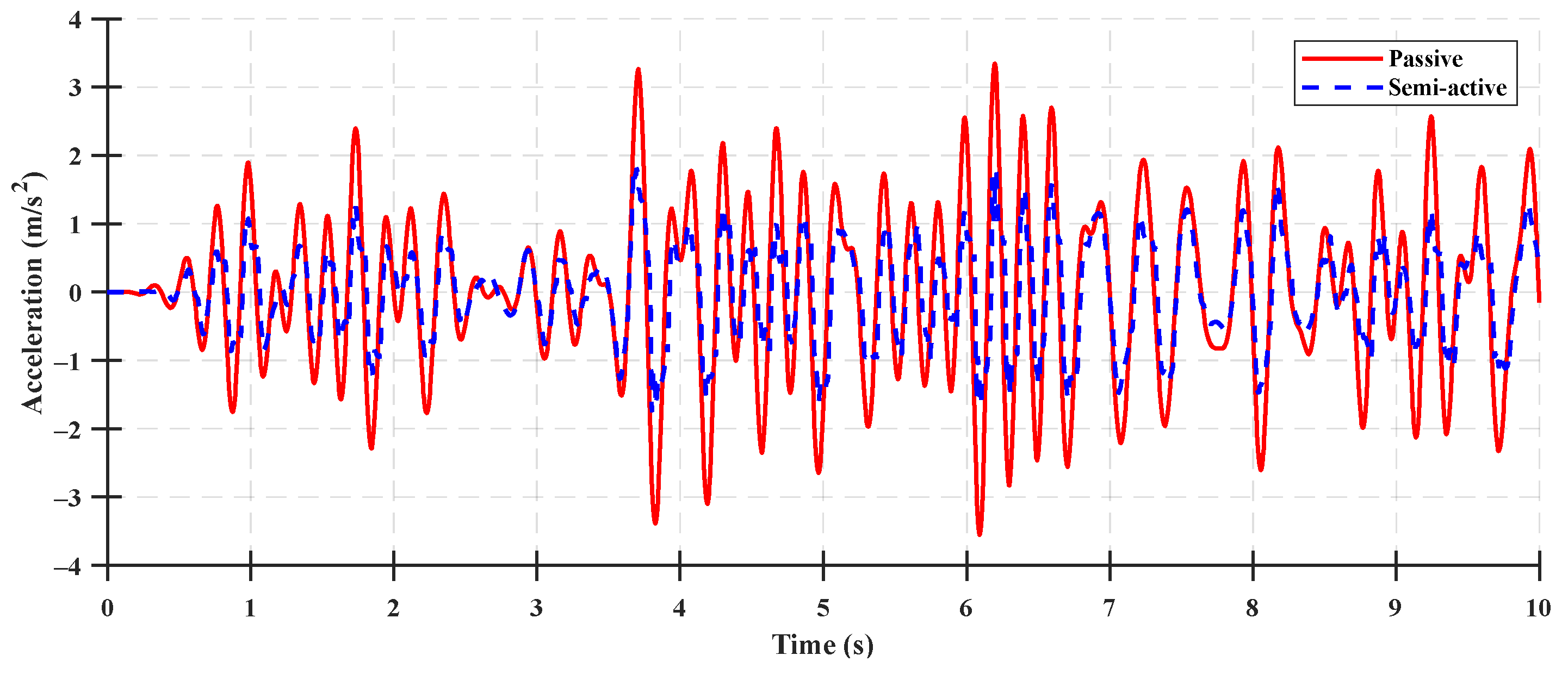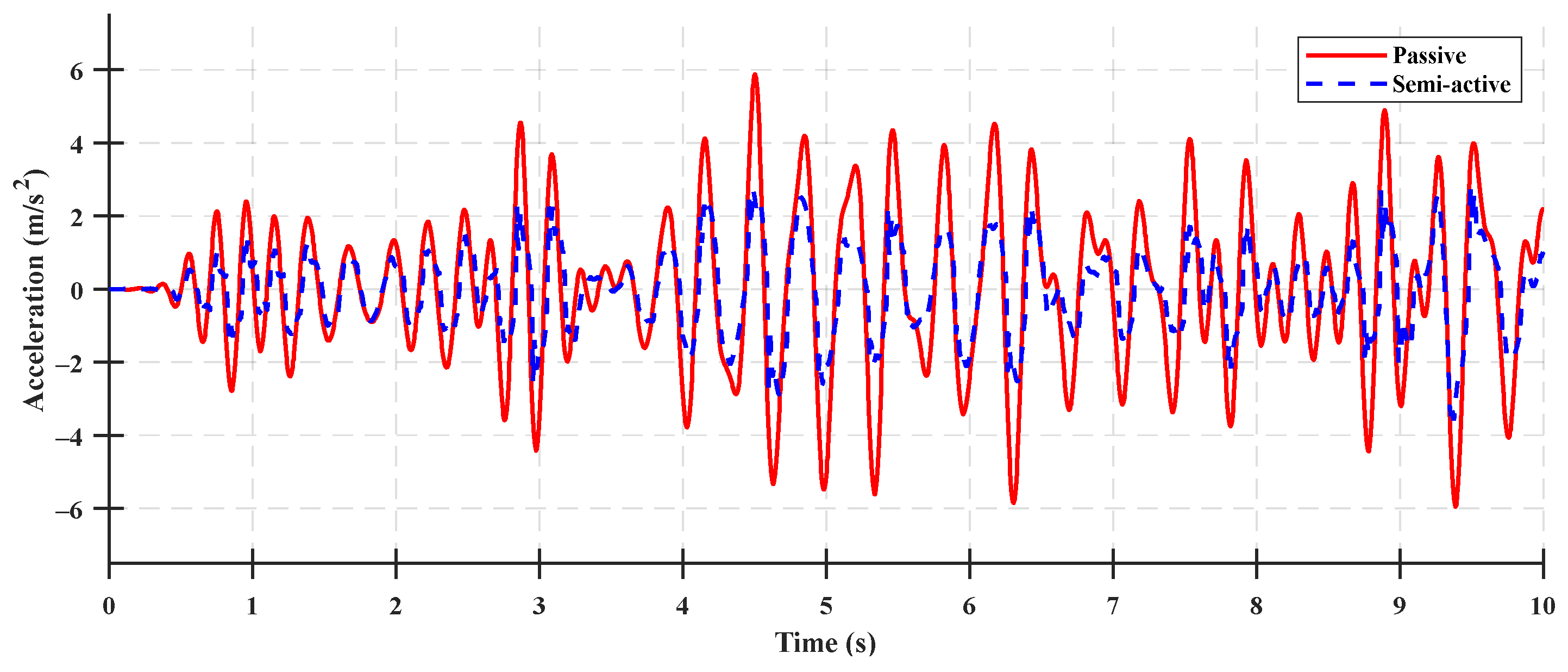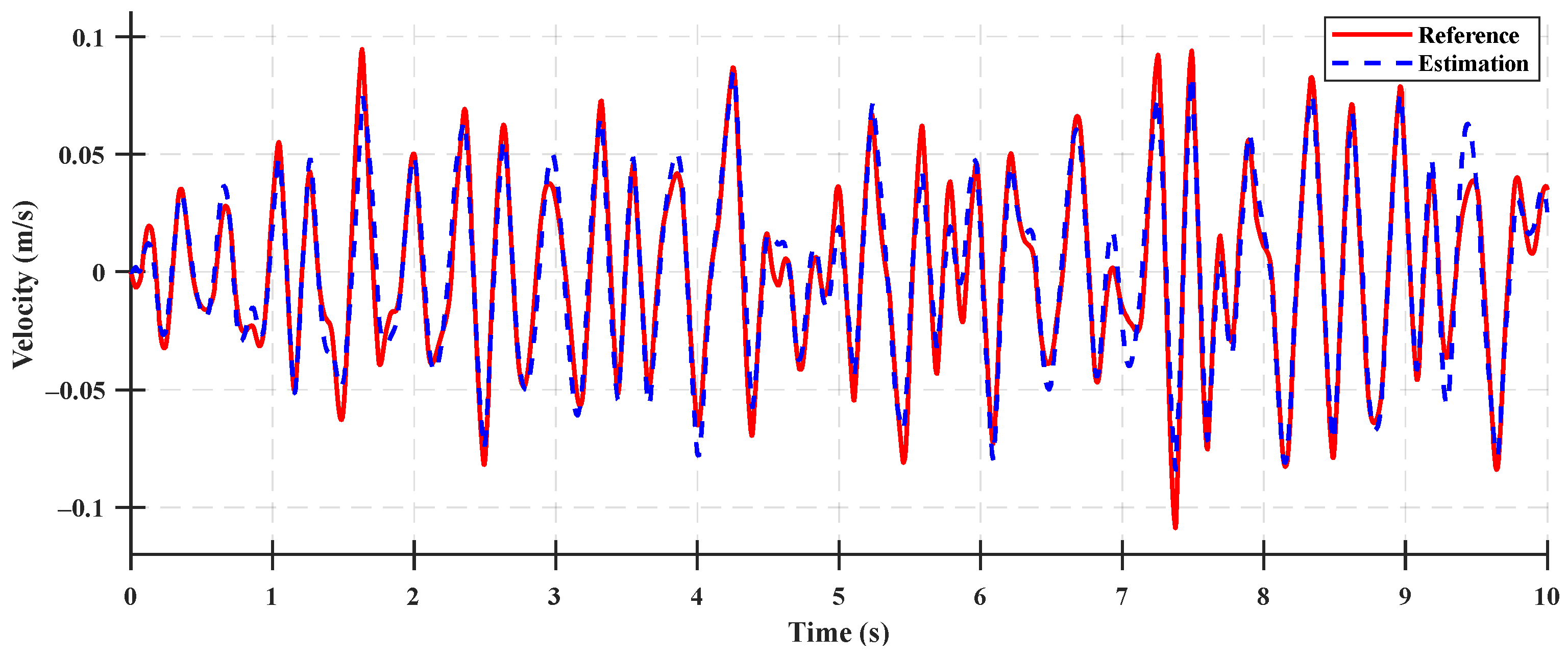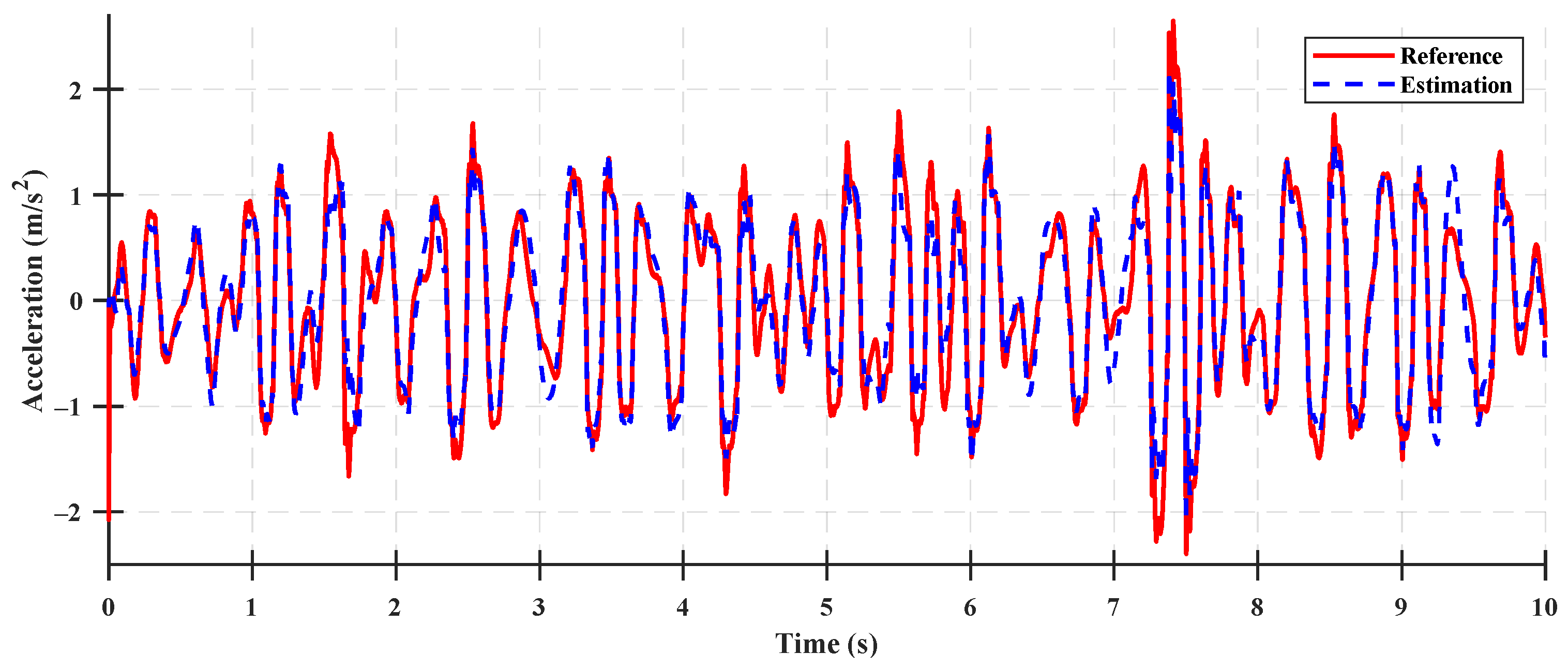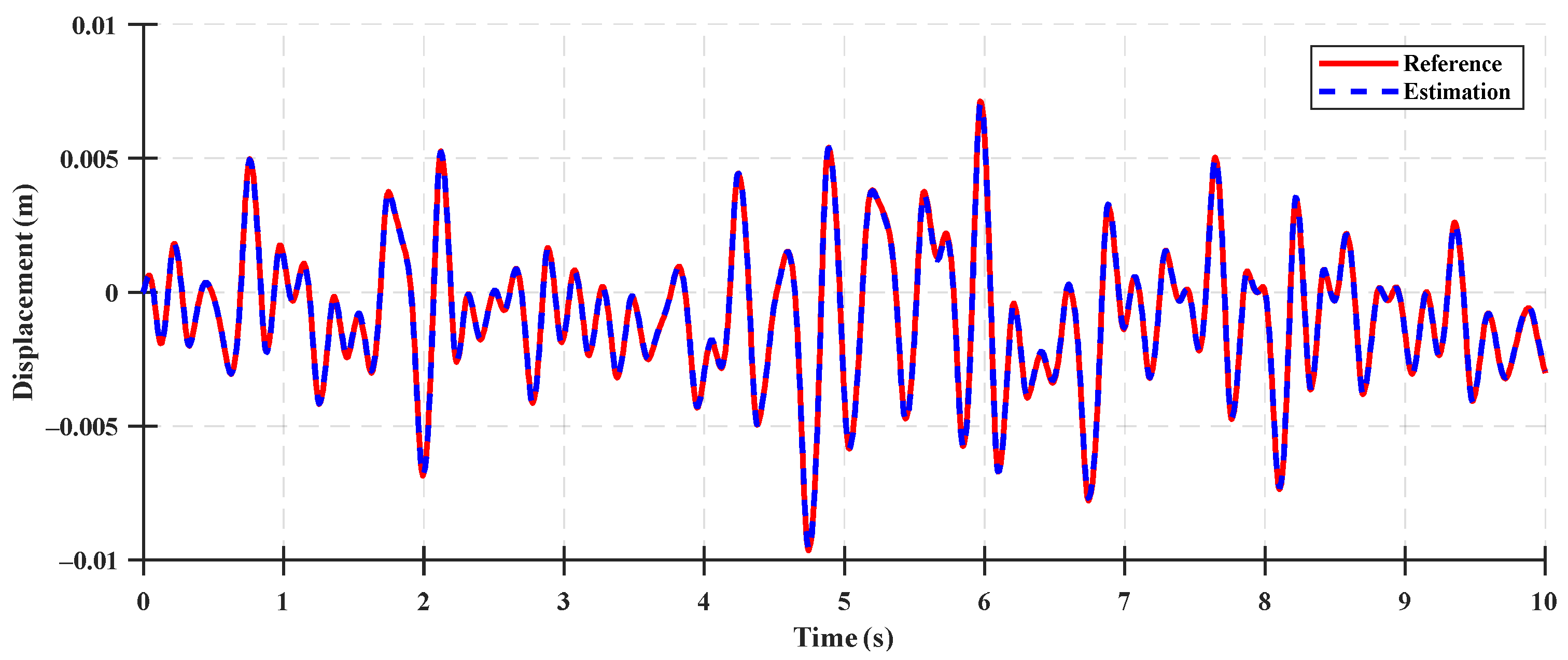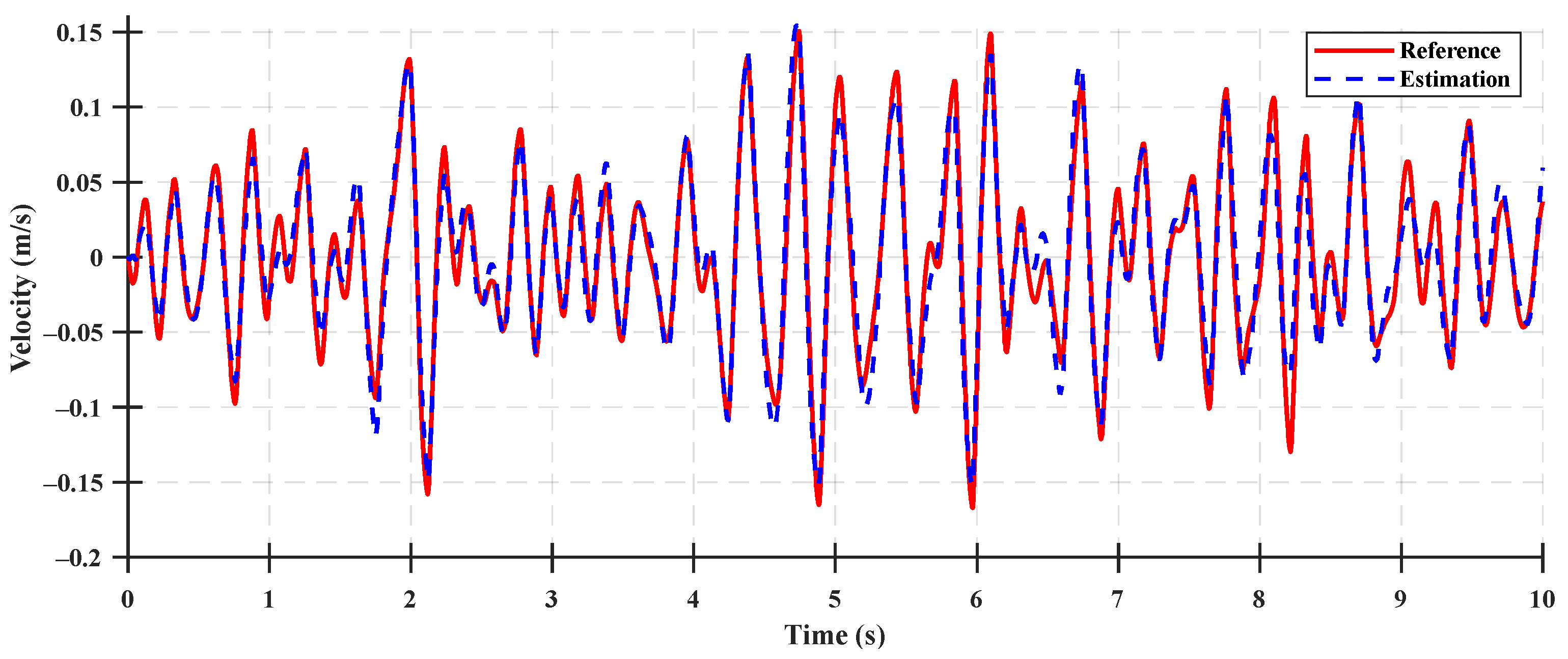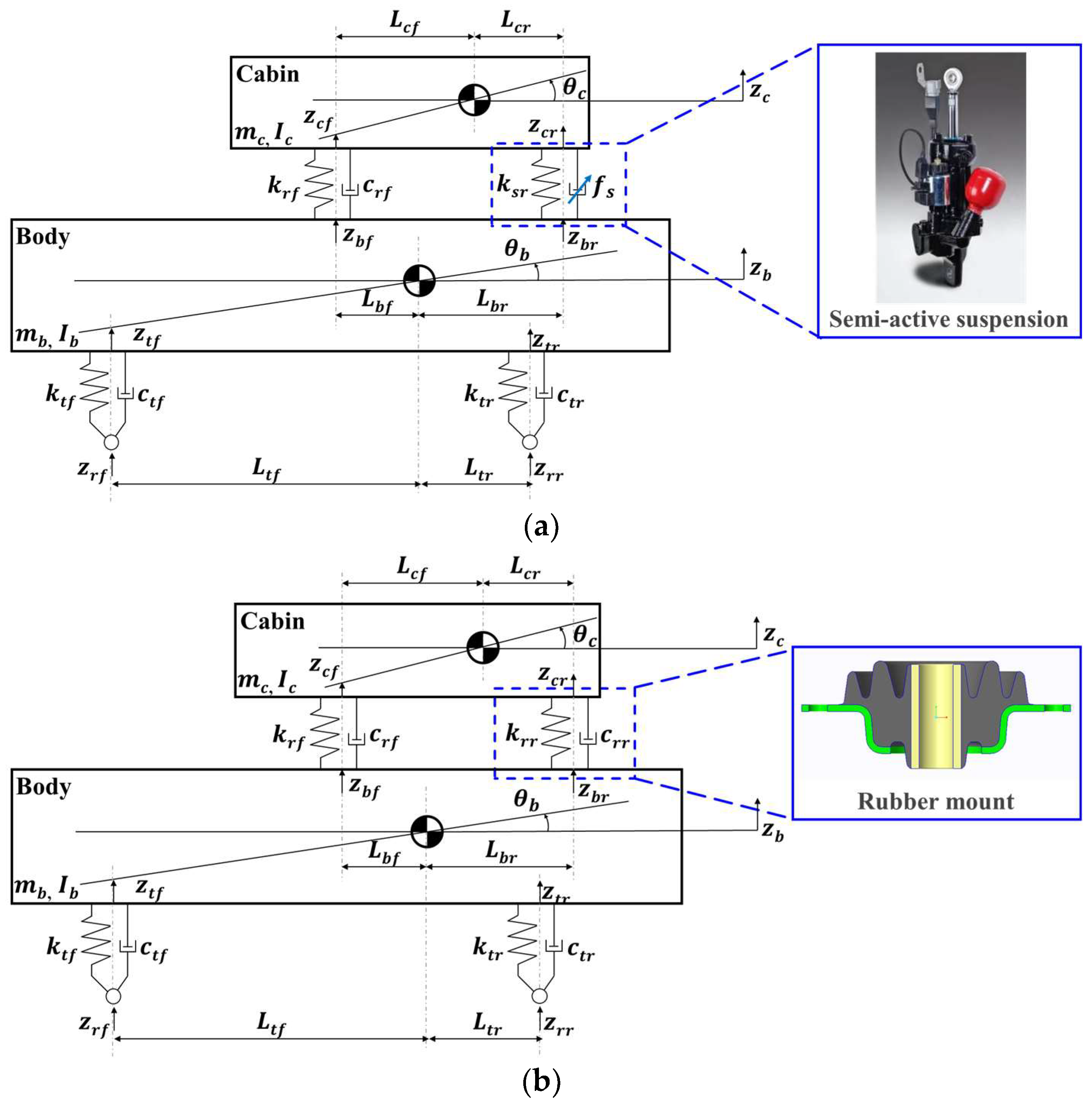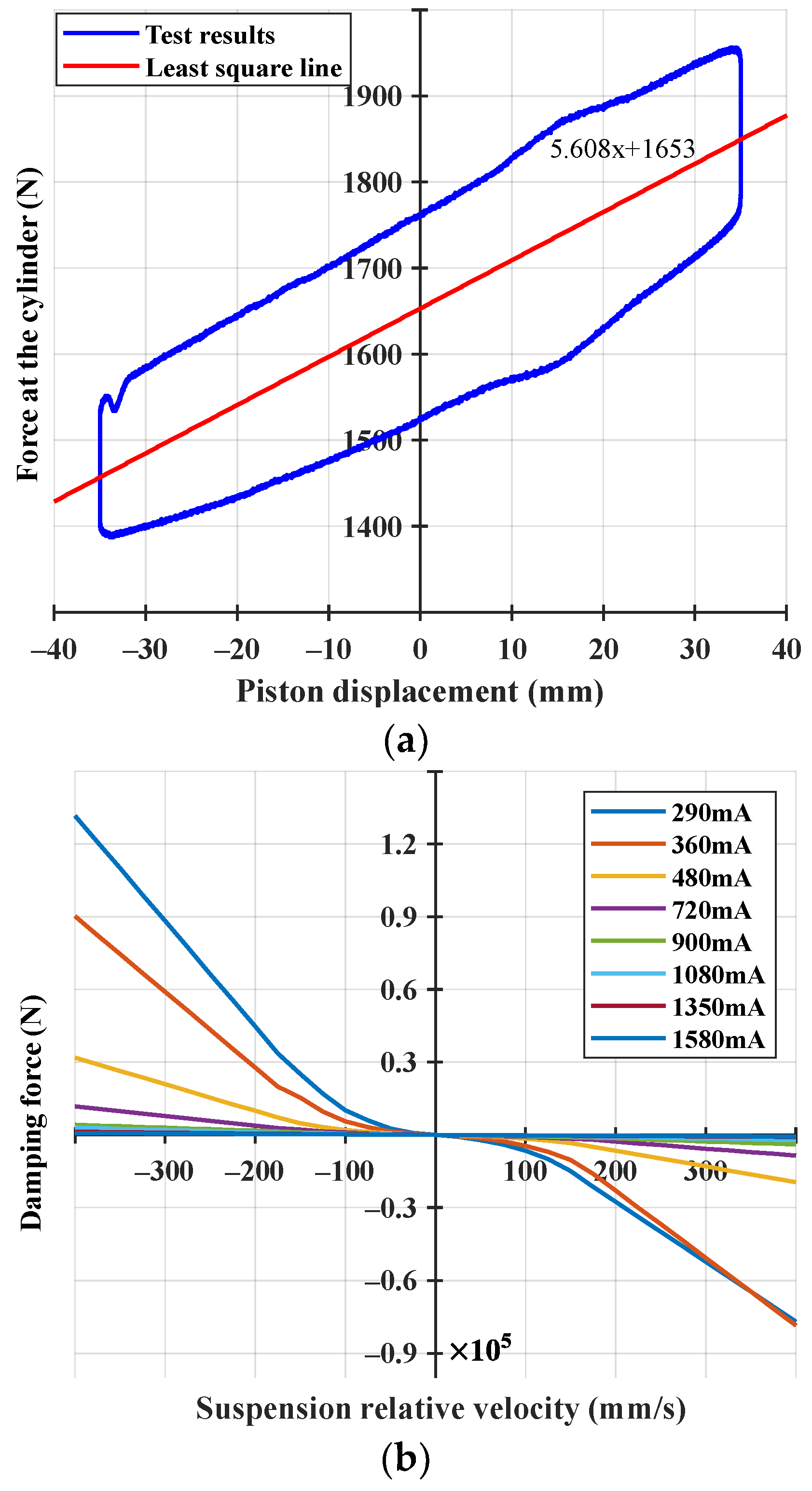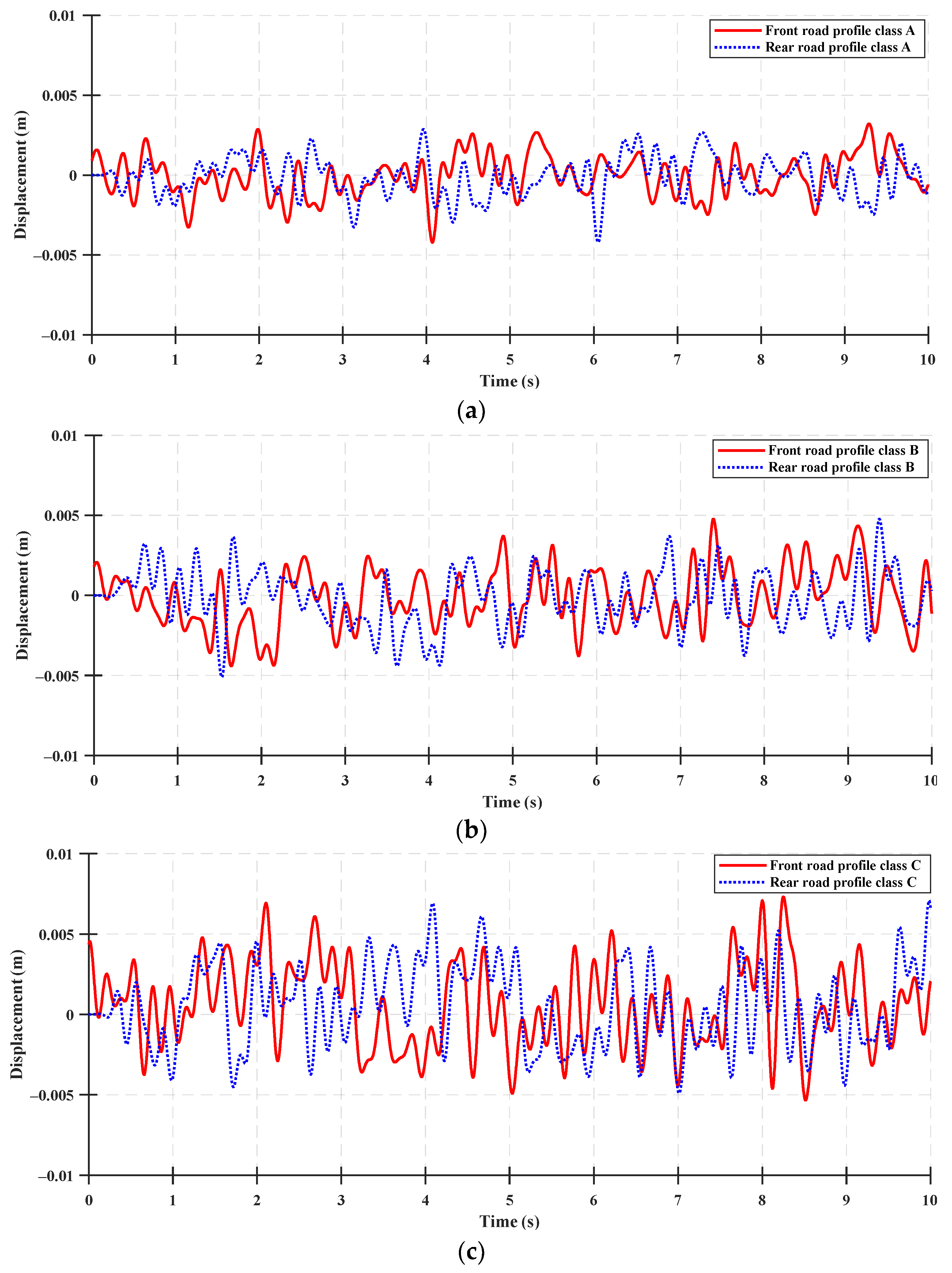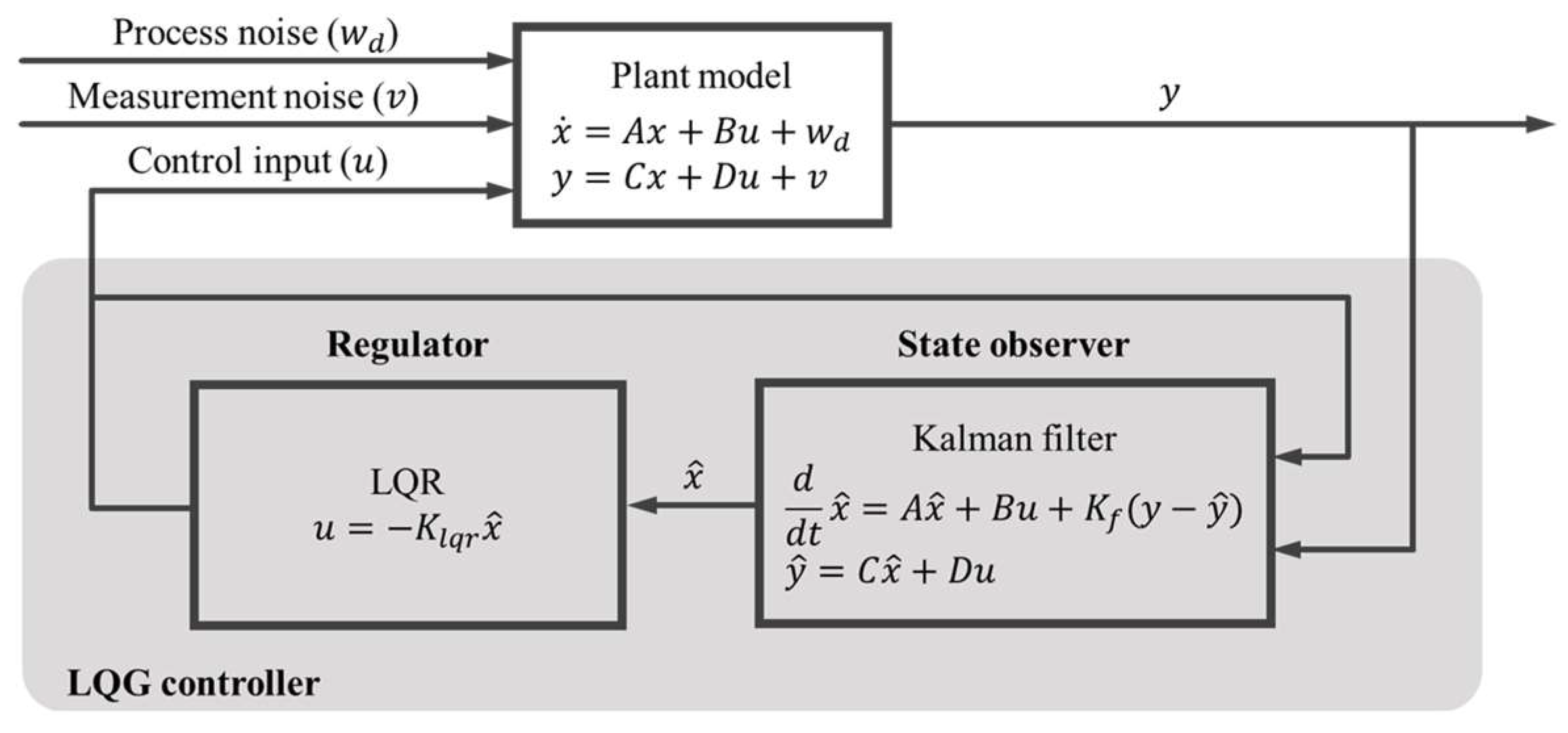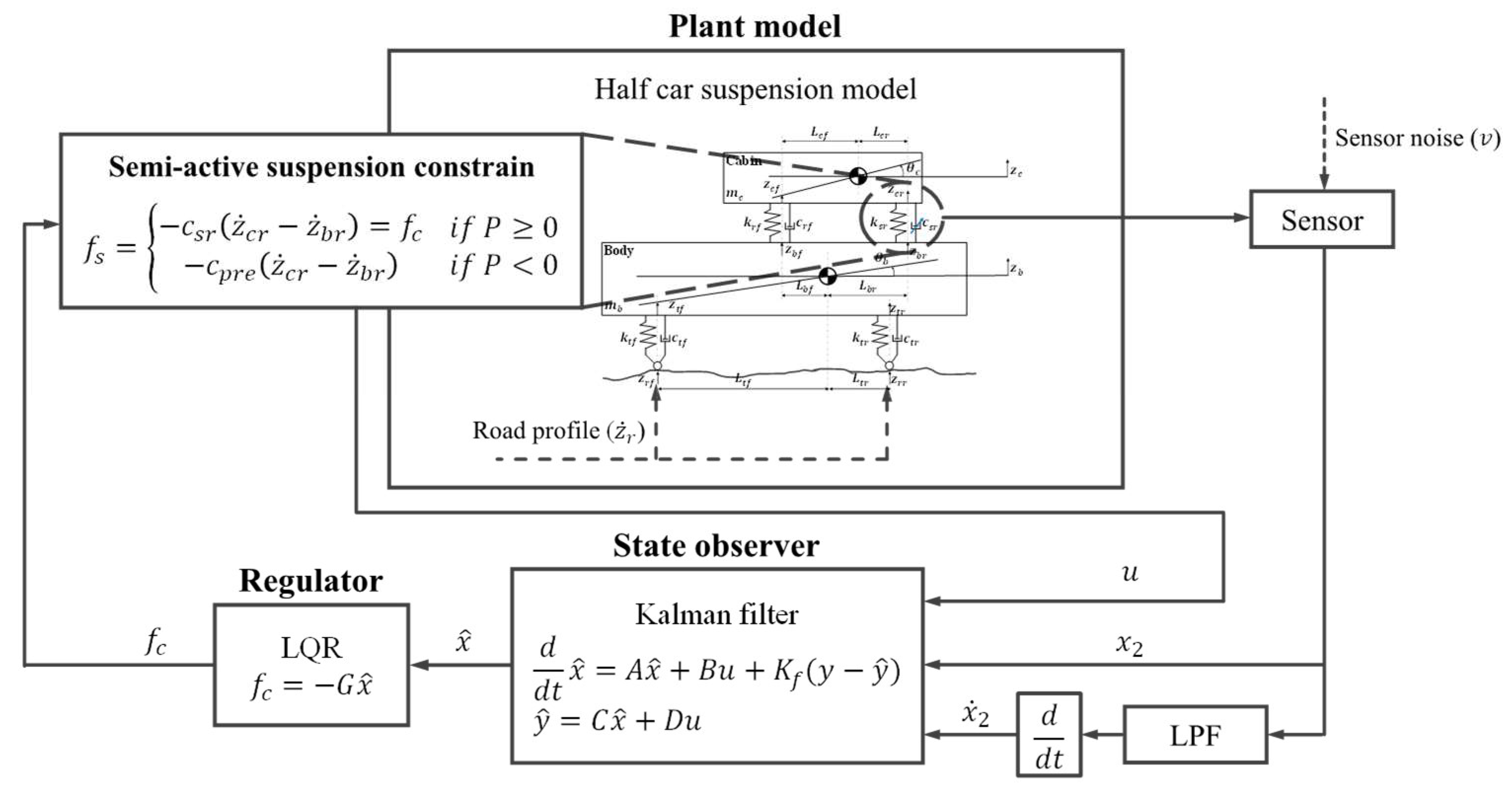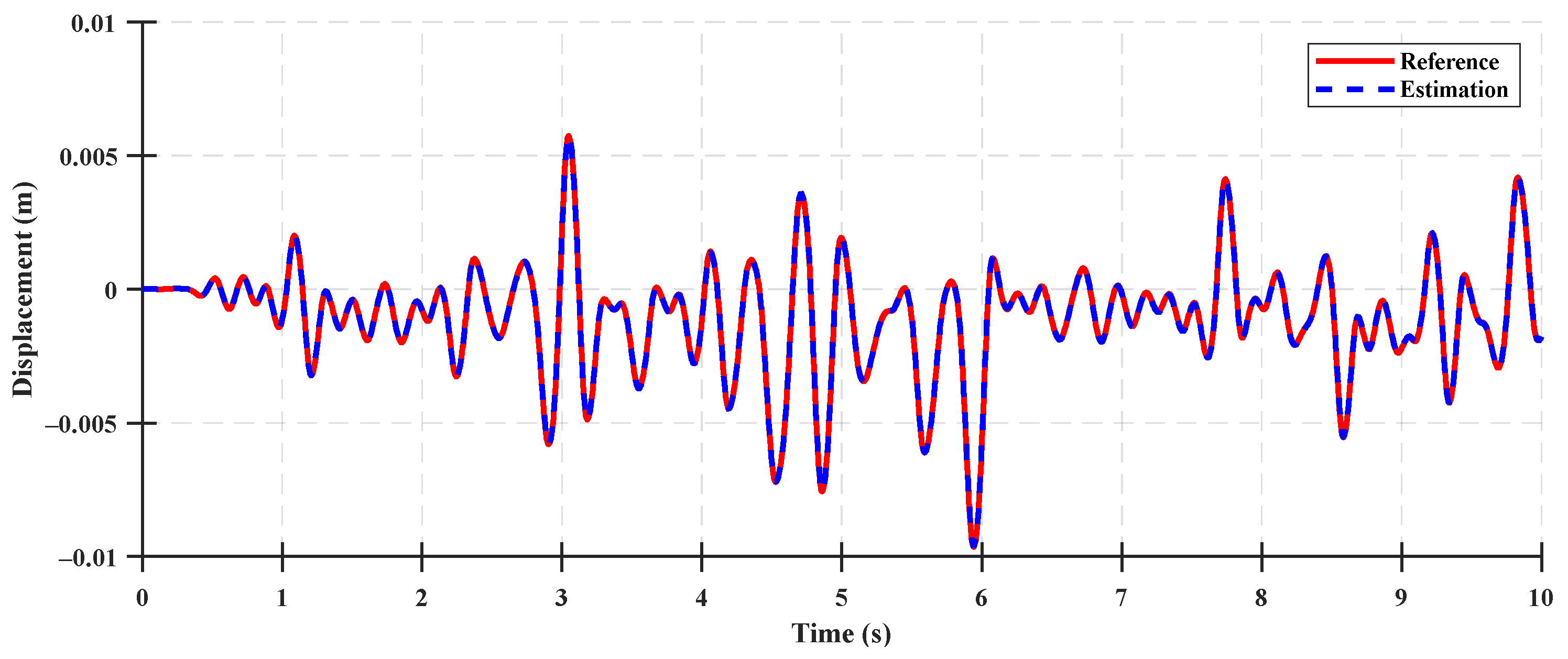2.1.1. Tractor Suspension Model
The tractor suspension model was composed of a half-car suspension model, as shown in
Figure 1. The half-car suspension model was represented as a linear 4-DOF system consisting of a sprung mass (tractor cabin) connected to an unsprung mass (tractor body). The sprung and unsprung masses were free of vertical and pitch motions. The suspension system between the cabin and body consisted of front and rear suspension systems. Moreover, it was subject to road disturbance input (from the road surface) because the body was in contact with the road surface via the tire.
Two half-car suspension models were developed to compare the riding vibrations with and without the suspension control algorithm.
Figure 1a presents a half-car suspension model in which the control algorithm was applied and the rear suspension was equipped with a semi-active suspension.
Figure 1b depicts a half-car suspension model in which the suspension control algorithm was not applied and the rear suspension was installed with a rubber mount. The additional elements in
Figure 1a,b are the same.
The front suspension system consisted of a rubber mount (passive suspension system). The rubber mount was modeled using a spring with a constant stiffness and damping coefficient. The rear suspension system of the half-car suspension model in which the control algorithm was not applied was composed of a rubber mount (passive suspension system), which was modeled using a spring of constant stiffness and damping coefficient. The rear suspension system of the half-car suspension model in which the control algorithm was applied was composed of a semi-active suspension system. The semi-active suspension system was modeled using a spring of constant stiffness and variable suspension damping coefficient. The damping coefficient of the semi-active suspension system exhibited a non-linear characteristic that varied with respect to the current of the proportional control valve. Its damping force was calculated as the product of the damping coefficient and relative velocity of the rear suspension between the cabin and body. The damping force was considered as the control input to the half-car suspension system. Finally, the front and rear tires were modeled using a spring of constant stiffness and damping coefficient. If the pitch angles of the cabin and body are sufficiently small, the vertical displacement of the cabin and body can be expressed as follows:
where
= vertical displacement of the front cabin;
= vertical displacement of the rear cabin;
= vertical displacement of the front body;
= vertical displacement of the rear body;
= vertical displacement of the front tire;
= vertical displacement of the rear tire;
= vertical displacement of the center of gravity of the cabin;
= vertical displacement of the center of gravity of the body;
= distance between the front cabin and the center of gravity of the cabin;
= distance between the rear cabin and the center of gravity of the cabin;
= distance between the front cabin and the center of gravity of the body;
= distance between the rear cabin and the center of gravity of the body;
= distance between the front tire and the center of gravity of the body;
= distance between the rear tire and the center of gravity of the body;
= pitch angle of the cabin;
= pitch angle of the body.
The equations can be expressed by applying the static equilibrium position as the vertical displacements of the centers of gravity of the cabin and body and pitch angles to a half-car suspension model (equipped with a rear semi-active suspension).
The equation of the force balance of the center of gravity of the cabin (motion for heave) can be expressed as follows:
The moment equation of balance of the center of gravity of the cabin (motion for pitch) can be expressed as follows:
where
= mass of the tractor cabin;
= centroidal moment of inertia of the tractor cabin;
= spring stiffness of the front rubber mount;
= damping coefficient of the front rubber mount;
= spring stiffness of the rear semi-active suspension;
= suspension force of the rear semi-active suspension.
The force balance equation of the center of gravity of the body (motion for heave) can be expressed as follows:
The equation of moment balance at the center of gravity of the body (motion for pitch) can be expressed as follows:
where
= mass of the tractor body;
= centroidal moment of inertia in the tractor body;
= front road vertical profile;
= rear road vertical profile;
= spring stiffness of the front tire;
= damping coefficient of the front tire;
= spring stiffness of the rear tire;
= damping coefficient of the rear tire.
Using Equations (7)–(10), the dynamic equation can be expressed in matrix form as follows:
The aforementioned matrix can be expressed as follows:
where
, , , , , , , , , , , , , and .
The variable of the center, upon multiplication with the transform matrix, is transformed into the variables of the front and rear suspensions as follows:
Using the transformation matrix and Equations (15)–(17), the dynamic equation and variables can be expressed as follows:
where
, and
.
The state variables of the half-car suspension model are defined as follows:
is the front suspension deflection;
is the rear suspension deflection;
is the front cabin velocity;
is the rear cabin velocity;
is the front tire deflection;
is the rear tire deflection;
is the front tire velocity; and
is the rear tire velocity. The state equation with the state variables of the half-car suspension model can be expressed as follows:
The aforementioned equation can be expressed as the following state-space equation:
where
The state-space equation with state variables for a half-car suspension model with a rear rubber mount is almost the same as that of a half-car suspension model with a rear semi-active suspension. The difference between the state-space equation of a half-car suspension model with a rear semi-active suspension and one with a rear rubber mount is dependent on whether the damping force is considered as a control input to the system. The damping force of the rear suspension, which is considered as the control input in a half-car suspension model equipped with a rear semi-active suspension, is not considered as the control input to one equipped with a rear rubber mount. Therefore, the state-space equation of the half-car suspension model equipped with a rear rubber mount can be expressed as follows:
where,
= spring stiffness of the rear rubber mount;
= damping coefficient of the rear rubber mount.
2.1.2. Semi-Active Suspension System
The semi-active suspension system demonstrated two characteristics, as follows:
(1) The suspension functioned only in the energy-dissipating direction of the system.
(2) The magnitude and direction of the damping force were determined using the non-linear characteristic curve with respect to the current of the proportional control valve.
Characteristic (1)
The mechanical power (
) of the semi-active suspension system is defined by Equation (29) using the control input (
) and relative velocity (
) of the suspension determined by the control law, where
indicates that the energy of the system is dissipated, and
indicates that the energy is supplied to the system. An active suspension can apply a control input
to the system regardless of the sign of
; however, a semi-active suspension can apply a control input
only when
[
17].
Characteristic (2)
The magnitude and direction of the damping force are determined using the damping coefficient
and the relative velocity of the rear suspension
from Equation (30). The suspension deflection is measured using a linear variable differential transformer (LVDT) in a semi-active suspension system. The relative velocity of the rear suspension is calculated by differentiating the measured rear suspension deflection. The damping coefficient was determined by the opening position of the orifice in the proportional control valve, which in turn was controlled by the proportional control valve current. Therefore, the damping force changed nonlinearly with respect to the valve current and the relative velocity of the rear suspension [
17].
where
= damping coefficient of the rear semi-active suspension.
The suspension damping force
is determined using Characteristics (1) and (2), as expressed by Equation (31). When
,
is determined by the control input
. When
,
is not controllable; therefore, it is determined not by
, but by the damping coefficient
from the previous step. The magnitude of
is determined only by
because
is a product of
and the relative velocity of the rear suspension. Therefore,
is controlled using the damping coefficient
and damping coefficient
from the previous step.
The semi-active suspension used in this study demonstrated the stiffness and damping characteristics shown in
Figure 2, and the characteristics of the semi-active suspension derived from a study by [
18] were adopted.

